1. Giới thiệu
“Sheet metal” commonly refers to metal stock from roughly 0.2 mm đến 6 mm độ dày (industry definitions vary).
Welding at this scale is a balancing act: deliver sufficient energy for a sound joint while minimizing distortion, burn-through and metallurgical damage.
Good outcomes require appropriate process selection (spot, vòng cung, Mắt, tia laze, khoe khoang), control of heat input, correct joint design and robust inspection.
2. What Is Sheet Metal Welding?
Sheet metal welding is the set of joining technologies used to create structural, functional or cosmetic joints in thin metal stock — typically from ≈0.2 mm up to ~6 mm thickness in industrial practice.
At this scale the goals are different from heavy-section welding: you must produce a sound joint while minimizing heat input, avoiding burn-through, controlling distortion, and preserving surface finish for final assembly or visible panels.
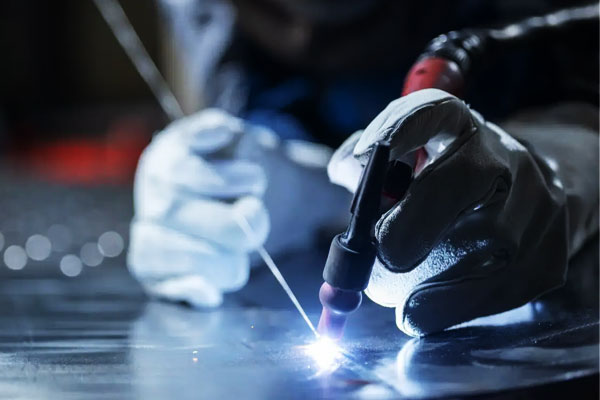

A concise definition
Sheet-metal welding is the controlled local application of energy (nhiệt, frictional or metallurgical) to fuse or metallurgically bond two or more sheet components so the joint meets required sức mạnh, Mệt mỏi, corrosion and cosmetic tiêu chuẩn, while keeping distortion and rework within acceptable limits.
What it includes (process families)
Sheet-metal welding is not one technology but a family of methods chosen to suit material, độ dày, joint geometry and production volume:
- Fusion welding — melts parent metal and usually adds filler (ví dụ., GMAW/MIG, GTAW/TIG, tia laze, huyết tương).
- Resistance welding — generates heat by electrical resistance at the interface (ví dụ., Hàn tại chỗ).
- Solid-state welding — joins without melting (ví dụ., Ma sát khuấy hàn (FSW)).
- Brazing and soldering — capillary flow of a lower-melting filler metal to join thin members without melting the base metal.
- Buộc chặt cơ học (rivets, clinching) and adhesives are sometimes used in combination with welding.
3. Common Welding Processes for Sheet Metal — In-Depth
Sheet-metal fabrication uses a small family of welding and joining technologies chosen to control heat input, biến dạng, appearance and cycle time.
Hàn hồ quang kim loại khí (GMAW / TÔI)
GMAW forms an electric arc between a continuously fed consumable wire electrode and the workpiece.
The arc ionizes the shielding-gas atmosphere, producing a plasma column that transfers thermal energy to the wire tip and to the workpiece surface.


Metal is transferred from the wire to the weld pool in discrete modes determined by current, wire diameter, wire chemistry, gas composition and arc dynamics:
- Short-circuit transfer: the molten tip contacts the workpiece briefly and current spikes cause rapid droplet detachment; the energy per droplet is low, giving limited penetration and minimal heat input — ideal for very thin sheet.
- Globular transfer: lớn hơn, gravity-influenced droplets form and fall; this mode is unstable and produces spatter.
- Spray transfer: high-current, continuous transfer of fine droplets across the arc; high deposition and deep penetration but higher heat input (better suited to thicker sections).
- Pulsed spray: a controlled peak-and-base current waveform that produces single-droplet transfer per pulse — combines low average heat input with spray-like droplet detachment for good finish on thin-to-medium sheet.
Electromagnetic forces (pinch effect) and surface tension govern droplet formation and detachment.
The weld pool dynamics (fluid flow, Marangoni convection influenced by sulfur/oxygen, and electromagnetic stirring) control bead shape and dilution.
Shielding gas composition influences arc stability, metal transfer mode and penetration (ví dụ., CO₂ raises droplet size and spatter; argon–oxygen mixtures stabilize spray transfer at lower currents).
Hàn hồ quang vonfram khí (GTAW / TIG)
GTAW uses a điện cực vonfram không tiêu hao to sustain a stable arc.
The arc is constricted and attaches to the base metal, transferring heat through ionized gas (huyết tương).
Since the electrode is not consumed, phụ kim loại (Nếu được sử dụng) is fed manually or automatically into the weld pool.
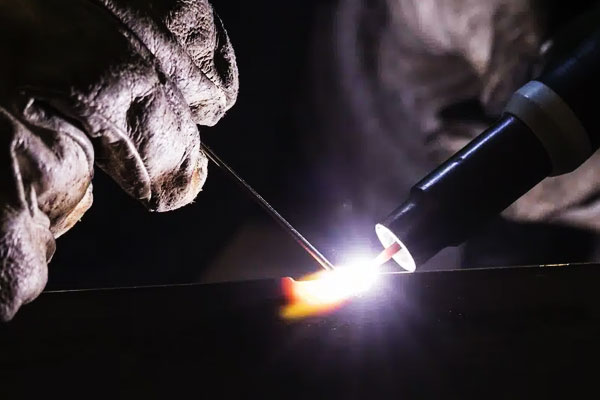

Key physical aspects:
- Arc column and heat concentration: TIG arcs are narrow and very controllable; small changes in current or torch angle have direct effects on local heat input.
- Shielding and arc chemistry: khí trơ (typically argon) prevents oxidation; for aluminium AC TIG,
the alternating polarity creates an oxide-cleaning (đánh bóng bằng điện) effect during electrode-positive half-cycle and penetration during electrode-negative half-cycle—this is critical to break the tenacious aluminium oxide skin. - Thermal conduction and radiative cooling: because the electrode is cooler and heat flows into the workpiece, TIG produces a predictable fusion zone with fine control over puddle size.
- Arc initiation and stability: high-frequency or lift-start systems enable controlled arc initiation without contamination; electrode selection (thoriated, ceriated, lanthanated) tailors electron emission and arc stability for different current ranges.
TIG allows precise thermal control and minimal molten pool turbulence, making it excellent for thin sheet and cosmetic welds where arc stability and cleanliness dominate performance.
Resistance Spot Welding (RSW)
Resistance spot welding is a Joule-heating process: high current is forced through the contacting sheet stack while compressive electrode force maintains intimate contact.
Local resistance at the contact interface (and to a lesser extent the bulk sheet resistance) converts electrical energy into heat rapidly, causing local melting and formation of a weld nugget.
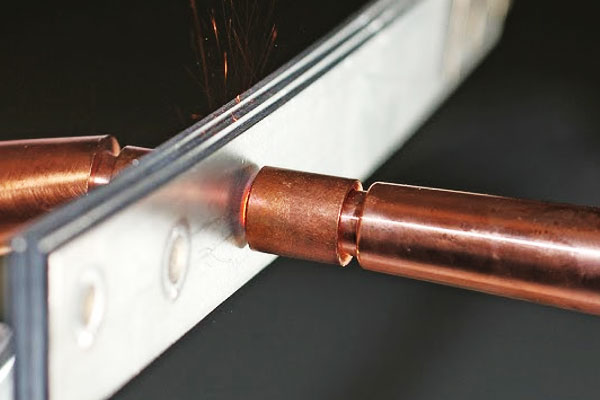

Important mechanistic points:
- Contact resistance vs bulk resistance: initial interface resistance dominates heating; as materials soften and molten metal forms, resistance changes dynamically — process control must account for this transition.
- Electrode force and heat distribution: compressive force squeezes out oxides and reduces contact resistance; it also controls nugget geometry by constraining molten metal and preventing expulsion.
- Thermal diffusion and cooling: after current is cut, the hold time and electrode cooling extract heat and solidify the nugget; electrode cooling (water-cooled copper electrodes) is critical to control nugget size and repeatability.
- Material and coating effects: lớp phủ (mạ điện, Lớp phủ hữu cơ) change contact resistance and may vaporize, affecting heat localisation and electrode life — schedules must be adjusted accordingly.
RSW is fundamentally an electro-thermal-mechanical process where electrical, thermal and mechanical variables interact on millisecond timescales to produce a metallurgical bond.
Ma sát khuấy hàn (FSW)
FSW is a solid-state, thermo-mechanical joining process. A rotating, profiled tool (shoulder + ghim) is plunged into the joint and traversed along it.
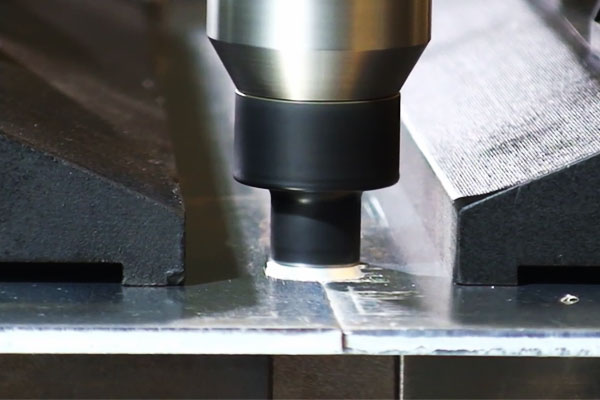

Mechanisms at work include:
- Frictional heating: the rotating shoulder and pin generate heat by friction at the tool–workpiece interface, raising temperature locally to a plastically flowable but sub-melting state.
- Material plasticized flow and stirring: the pin’s geometry forces material from the leading edge to flow around the pin and consolidate in the wake, closing voids and breaking up initial oxide films—resulting in a fine-grained dynamically recrystallized “stir zone”.
- Mechanical forging action: the shoulder exerts forge pressure, consolidating the stirred material and producing a defect-free joint with no fusion-related porosity.
- Microstructural evolution: severe plastic deformation and dynamic recrystallization refine grains and often produce superior mechanical properties compared with fusion welds.
Because FSW avoids melting, it eliminates solidification defects (ví dụ., độ xốp, Vết nứt nóng) and produces low distortion; Tuy nhiên, successful welding requires rigid backing and careful control of tool geometry and process kinematics.
Hàn chùm tia laser (LBW) & Hybrid Laser-Arc Welding
Laser welding transmits energy in a highly collimated beam that couples into the surface, producing two primary conduction modes:
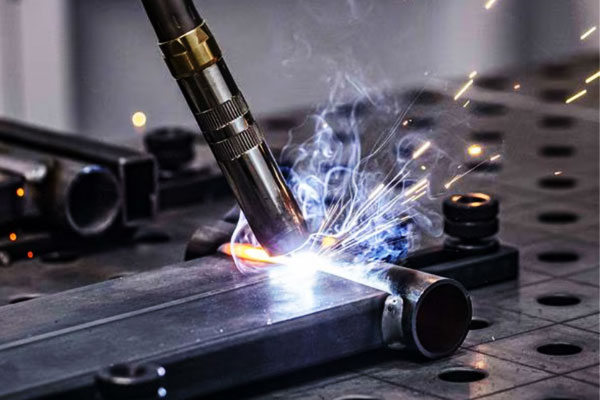

- Conduction mode: at lower power density the laser heats the surface and melts material by conduction; penetration is shallow and heat-affected zone (HAZ) is modest.
- Keyhole mode: at high power densities the beam vaporizes a column of metal creating a vapour-filled cavity (lỗ khóa). Intense absorption at the keyhole walls causes deep penetration as the keyhole is sustained; recoil pressure and fluid dynamics around the keyhole govern molten pool flow and stability.
Key physical factors include absorption (vật liệu, điều kiện bề mặt), reflectivity (highly reflective metals like Al and Cu reduce coupling), and keyhole stability (sensitive to joint fit-up and the presence of contaminants).
Hybrid laser-arc welding couples a laser with an arc (usually MIG) — the arc improves gap-bridging, preheats the joint and supplies filler while the laser provides deep penetration and narrow HAZ.
Synergy arises because the arc increases molten metal availability and reduces sensitivity to minor gaps, while the laser controls penetration and reduces distortion.
Hàn hồ quang plasma (CHÂN)
PAW generates a constricted plasma jet by forcing a plasma gas (argon, hydrogen mixes) through a fine nozzle around a tungsten electrode.
The constriction raises gas temperature and ionization, producing a focused, high-energy density arc that can be used in either:
- Transferred mode: arc attaches to the workpiece and heat transfer is concentrated; suitable for deeper penetration.
- Non-transferred (pilot) mode: arc is sustained between electrode and nozzle for specialized pre-heating or ignition tasks.
The plasma jet’s higher energy density and laminar flow produce stable penetration with better control than conventional TIG;
gas chemistry (H₂ addition) increases enthalpy and penetration at the cost of potential hydrogen pick-up in susceptible alloys.
The nozzle geometry and gas flow control are therefore critical parameters for arc shape, penetration and weld pool behavior.
Oxy-fuel, Brazing and Soldering (for thin-gauge, phi cấu trúc)
These are capillary and temperature-controlled joining methods rather than fusion welding:
- Oxy-fuel (Ngọn lửa) welding/brazing: a combustion flame (O₂ + fuel gas) supplies localized heat.
In brazing the filler alloy (with melting point below base metal) is heated to flow by capillarity into the joint clearance without melting the base metals.
Flame chemistry and flux manage oxide dissolution and wetting. Oxy-fuel welding (fusion) melts parent material and filler—rare for sheet work because of coarse heat control. - Khoe khoang: relies on làm ướt—the molten filler must flow over and adhere to the base metal surfaces, displacing oxides; fluxes or controlled atmospheres remove oxides and promote wetting.
Capillary action controls filler distribution; joint clearance is critical (typical brazing clearance 0.05–0.15 mm). - hàn: similar to brazing but at lower temperatures (<450 °C); surface tension and solidification control joint integrity in electronics and light assemblies.
Because base metals are not melted, brazing and soldering produce minimal distortion and are well suited to dissimilar metal joining; success depends on metallurgy of filler, flux chemistry and strict cleanliness and clearance control.
4. Material Considerations and Weldability
Welding sheet metal is as much about material behaviour as it is about process selection.
Different alloys respond very differently to heating, đổ, solidification and cooling:
thermal conductivity controls how heat spreads, alloy chemistry controls cracking susceptibility and post-weld properties, and surface condition controls arc stability and porosity.
| Material group | Tính hàn (tờ giấy) | Typical processes | Key concerns / các hiệu ứng | Typical filler & che chắn |
| Thép carbon / Thép hợp kim thấp | Good → Conditional | GMAW (short-circuit/pulse), GTAW, RSW | HAZ hardening on higher C or thick sections; biến dạng; hydrogen-induced cold cracking if moisture/contaminants present | ER70S-6 (TÔI); Ar/CO₂ mixes; preheat/postheat for higher CE steels |
| Thép không gỉ (austenit) | Rất tốt | GTAW, pulsed GMAW, tia laze | Nhạy cảm (kết tủa cacbua) if overheated → corrosion; narrow HAZ; distortion control | ER308L / ER316L (low-C filler), 100% Ar (TIG), Ar blends (TÔI) |
| Thép không gỉ (ferritic/ martensitic) | Thử thách | TIG, MIG with preheat | Martensitic: HAZ hardening and cracking risk; ferit: Tăng trưởng hạt & sự giòn giã | Martensitic: matching filler + post-weld tempering; control preheat (100Mùi300 ° C.) |
Nhôm & hợp kim | Good — process sensitive | TIG (AC), pulsed MIG (spool-gun), tia laze, FSW | Độ dẫn nhiệt cao; tenacious oxide (Al₂O₃) needs removal; porosity and hot-cracking risk in some alloys | Al fillers: ER4043 (Và, good fluidity), ER5356 (Mg, sức mạnh cao hơn); 100% Ar or Ar/He |
| đồng, thau, đồng | Moderate → Special handling | TIG, tia laze, khoe khoang (preferred for thin) | Very high conductivity (Củ) → heat loss; brass releases Zn fumes; risk of burn-through and vaporization | đồng: Cu-Si filler; thau: brazing filler; argon shielding; good ventilation |
| Galvanized / coated steels | Condition-dependent | MIG/TIG with local strip, RSW (with controls), laser+extraction | Zinc vaporizes → porosity, spatter and toxic fumes (metal-fume fever); electrode life reduction in RSW | Strip coating at weld area or use local extraction; PPE and fume control mandatory |
5. Thiết kế chung, Fit-up and Edge Preparation
Good joint design reduces heat input demands and improves quality.
- Lap joints are common in spot welding and MIG for sheet; beware of trapped water or corrosion pockets.
- Butt joints on thin sheet require excellent edge preparation (quảng trường, close gap) for laser or TIG. Root gap typically 0–0.5 mm for laser; TIG may tolerate more.
- Fillet welds: For strength and stiffness, limit throat size to avoid burn-through. Typical fillet leg for 1 mm sheet is ~1–2 mm but must be carefully controlled.
- Edge bevels: Not usually needed for thin sheet; Nếu được sử dụng, keep bevel shallow to avoid excess filler and heat.
- Dung sai: For laser and FSW, fit-up tolerances are tight (±0.1 mm or better). For MIG/TIG on very thin materials, khoảng trống <0.5 mm are common to avoid burn-through.
6. Đầu vào nhiệt, Distortion Control and Fixturing Strategies
Thin sheet warps easily—control strategies include:
- Lower heat input: pulse welding, higher travel speed, short-circuit transfer in GMAW, pulsed MIG/TIG.
- Intermittent stitching: weld segments with gaps to relieve stress; final pass fills gaps.
- Balanced welding sequence: weld symmetrical locations and backstep technique.
- Strong fixturing and tacks: clamps and spot tacks before full weld reduce movement.
- Heat sinks and backing bars: copper backing dissipates heat and prevents burn-through.
- Pre-bending/over-control: intentionally pre-distort then weld to end up flat after release.
7. Khiếm khuyết, Root Causes and Countermeasures
| Khuyết điểm | Symptoms | Root Causes | Countermeasures |
| Burn-through | Hole in sheet, local melt-out | Excess heat input, slow travel, thin section | Reduce current/heat, increase travel speed, backing bar, stitch welding |
| độ xốp | Pits / gas holes in weld | Contaminants, độ ẩm, poor shielding | Clean surfaces, dry wire/filler, improve gas coverage, purge back side |
| Lack of fusion | Unfused toes or root | Low heat input, bad fit-up | Increase energy, reduce travel speed, correct joint prep |
| vết nứt (hot/cold) | Cracks in HAZ or weld | High restraint, hydro, làm mát nhanh | Low-H consumables, pre/post-heat, peening or stress relief |
| Excessive spatter | Spatter around bead (TÔI) | Incorrect transfer mode / khí đốt | Switch to pulsed or short-circuit, adjust gas mix |
| Undercut | Groove at weld toe | Excessive voltage or travel speed | Reduce voltage, slow travel, adjust torch angle |
| Ô nhiễm bề mặt / sự đổi màu | quá trình oxy hóa, poor appearance | Inadequate shielding or contamination | Improve shielding, clean prior to welding |
| Spot weld failure | Shallow or no nugget, expulsion | Incorrect electrode force, current or time | Adjust squeeze force and current schedule, replace electrodes |
8. Điều tra, Kiểm tra và đảm bảo chất lượng
Quality practices for sheet welding:
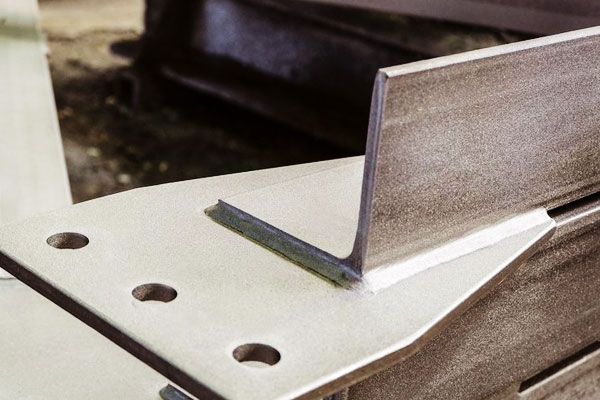

- Kiểm tra trực quan: weld profile, undercut, bắn tung tóe, surface discontinuities.
- Dye penetrant (Pt): sensitive surface crack detection.
- siêu âm (UT): can detect subsurface defects for thicker sheet or multi-layer.
- Cross-tension test / peel test: used to qualify spot weld strength.
- Kiểm tra cơ học: độ bền kéo, uốn cong, and microhardness tests on representative coupons.
- Kiểm soát kích thước: measure flatness and distortion; correct with fixtures or rework.
- Process control documents: WPS, PQR and welder qualifications per applicable standards.
9. Practical Tips for Welding Sheet-Metal Materials
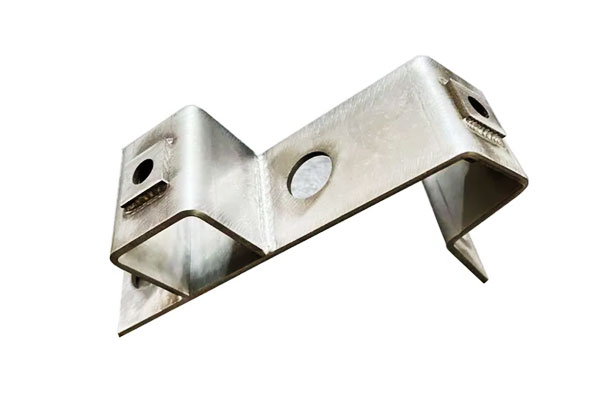

Before you start — preparation checklist
- Identify material & tính khí. Confirm alloy (ví dụ., 304L vs 304), thickness and any coatings. If unknown, sample and test.
- Clean the joint. Remove oil/grease, bụi bẩn, mill scale and heavy oxides. For aluminium remove oxides mechanically or rely on AC TIG oxide cleaning. For galvanized, strip the zinc from the immediate weld area if possible.
- Fit-up & tack. Use tack welds every 25–50 mm for thin panels; smaller spacing (10–25 mm) for long seams or thin, flexible parts. Ensure clamps hold parts flat and aligned.
- Dry filler & vật tư tiêu hao. Keep filler wire and rods sealed/dry; bake electrodes if required by spec.
- Plan heat control. Identify where backing bars, heat sinks or stitch welding will be used. Prepare fixtures and thermal clamps.
- Fume control & PPE. Local exhaust for galvanized, thau, không gỉ; respirators where required. Eye, hand and body protection appropriate to process.
Quá trình & parameter heuristics (starter rules)
These are starting points—always validate on a coupon that reproduces stack-up, coating and clamping.
GMAW / TÔI (thin steel 0.8–1.5 mm)
- Dây điện: 0.8 mm ER70S-6.
- Transfer: short-circuit for ≤1.5 mm; pulsed for higher quality.
- Hiện hành: 60–140 A (start low, increase carefully).
- Điện áp: 16–22 V.
- Travel speed: 200–600 mm/min.
- Shield gas: 75% Ar/25% CO₂ (tiết kiệm) hoặc 98% Ar/2% O₂ (better wetting).
GTAW / TIG (thin stainless & nhôm)
- không gỉ (1.0 mm): DCEN 35–90 A; Ar flow 8–15 L/min.
- Nhôm (0.8Cấm2,0 mm): AC 60–160 A; pulse & balance control helpful; use torch starts (HF or lift) to protect electrode.
- vonfram: 1.6–2.4 mm lanthanated/ceriated for DC, thoriated or lanthanated for AC.
Resistance Spot Welding (0.8 + 0.8 mm mild steel)
- Electrode force: 3–6 kN.
- Weld current: 7–12 kA (máy móc & electrode dependent).
- Weld time: 200–600 ms (depending on mains frequency and schedule).
- Maintain electrodes: dress faces regularly; monitor nugget size via destructive/non-destructive sampling.
Hàn laze (1.0 mm stainless butt)
- Quyền lực: 1–4 kW depending on travel speed.
- Tốc độ: 1–5 m/min for thin sheet.
- Focus spot: 0.2Hàng0,6 mm; ensure excellent edge quality and tight fit-up.
- Back purge: argon 5–15 L/min for stainless to prevent oxidation.
FSW (aluminium panels)
- Tool rpm: 800–2000 rpm; traverse 100–500 mm/min (tradeoff speed vs heat).
- Use robust backing plate; tool design critical for thin sheet to avoid plunge defects.
Controlling distortion and burn-through
- Use low heat input methods: TIG, pulsed MIG, laser or FSW when distortion or visual appearance is critical.
- Stitch/skip welding: weld 10–30 mm, skip 10–30 mm, then return to fill gaps—this limits local heat buildup.
- Balance sequence: weld symmetrically about the part and alternate sides. For seams, backstep in short segments to control shrinkage.
- Kẹp & backing: rigid clamps and copper backing bars dissipate heat and prevent burn-through; sacrificial backing sheet is effective for very thin parts.
- Pre-bend and over-compensate: intentionally slightly distort opposite to predicted warpage so the part relaxes into spec after welding.
- Use heat sinks: temporary copper blocks or water-cooled fixtures under critical areas reduce HAZ and warpage.
Tack, fixturing and alignment tips
- Minimal tack size: use small tacks—just enough to hold part—then finish with full welds. For thin sheet use tack lengths of 3–6 mm.
- Tack order: place tacks to minimize gaps; do not over-tack as excessive tacks equal excessive local heating.
- Fixture heating: if parts frequently distort, consider actively water-cooled fixtures or ceramic pads to control thermal flow.
- Quick change pallets: for production, design fixtures that guarantee repeatable fit-up and minimize cycle time.
Vật tư tiêu hao, dụng cụ & BẢO TRÌ
- Electrode & tip care: for MIG/TIG keep contact tips and nozzles clean; replace worn tips—worn tips cause erratic wire feed and inconsistent arcs.
- Wire selection: match wire chemistry to base metal and finish; maintain dry spools.
- Electrode dressing (RSW): dress copper electrodes to correct face geometry; worn electrodes reduce contact and increase current requirement.
- Torch angle & stick-out: maintain consistent stick-out for MIG (~10–20 mm typical) and proper torch angle (10Hàng20 °) to control penetration and bead shape.
10. Process Selection Matrix: When to Use Which Method
| Quá trình hàn | Sheet Thickness Range | Sự phù hợp của vật liệu | Ưu điểm chính | Ứng dụng điển hình |
|---|---|---|---|---|
| GMAW / TÔI | 0.8 – 12 mm | Thép cacbon, thép không gỉ, nhôm | Nhanh, easy automation, moderate heat input | Tấm ô tô, industrial enclosures, khung cấu trúc |
| GTAW / TIG | 0.5 – 6 mm | Thép không gỉ, nhôm, hợp kim đồng | Chính xác, clean welds, minimal spatter | Hàng không vũ trụ, high-quality assemblies, decorative panels |
| Resistance Spot Welding (RSW) | 0.5 – 3 mm | Thép cacbon, thép không gỉ | Rất nhanh, có thể lặp lại, biến dạng tối thiểu | Automotive body panels, appliance manufacturing |
| Ma sát khuấy hàn (FSW) | 1 – 12 mm | Nhôm, đồng, magie | Solid-state weld, cường độ cao, low distortion | Aircraft fuselage panels, tàu tàu, linh kiện hàng không vũ trụ |
| Hàn chùm tia laser (LBW) & lai | 0.3 – 6 mm | Thép không gỉ, nhôm, high-strength steel | Thâm nhập sâu, Đầu vào nhiệt thấp, tốc độ cao | ô tô, thiết bị y tế, precision assemblies |
| Hàn hồ quang plasma (CHÂN) | 0.5 – 6 mm | Thép không gỉ, hợp kim niken, titan | Chất lượng cao, controlled arc, narrow HAZ | Hàng không vũ trụ, hạt nhân, linh kiện hiệu suất cao |
| Oxy-fuel, Khoe khoang, hàn | 0.1 – 3 mm | đồng, thau, thin steel, coated metals | Low heat, Tham gia kim loại không giống nhau, biến dạng tối thiểu | HVAC, thiết bị điện tử, đồ trang trí |
11. Phần kết luận
Welding sheet metal successfully requires matching process capability to the material, joint and production needs.
The key decisions are about Quản lý nhiệt, joint fit-up, Và Kiểm soát quá trình. For high volumes with simple lap joints, resistance spot welding is most economical.
For cosmetic seams and repair work, TIG is preferred. Trình độ cao, low-distortion production, tia laze hoặc FSW may be the right choice. Always validate with representative coupons, control welding variables, and implement inspection and QA.
Câu hỏi thường gặp
What is the thinnest sheet I can weld?
With proper technique (tia laze, TIG or pulsed MIG), sheets down to 0.3Hàng0,5 mm can be welded without burn-through. Resistance spot welding works well for lap joints at ~0.6 mm per sheet.
How can I reduce distortion in welded sheet assemblies?
Minimize heat input (higher travel speed, pulsed modes), use balanced welding sequences, strong fixturing and stitch welding. Use backing bars and clamps to act as heat sinks.
Can I weld dissimilar metals (ví dụ., steel to aluminium)?
Direct fusion welding of steel to aluminium is problematic due to brittle intermetallics. Preferred options are khoe khoang, mechanical fastening, hoặc solid-state joining (friction welding or friction stir technique) with transition layers.
Do coatings like galvanizing prevent welding?
Coatings complicate welding: zinc vaporises and can cause porosity and toxic fumes. Remove coating at the weld area or use processes tolerant of coatings (laser with extraction) and always use fume extraction and PPE.
When should I choose FSW over fusion welding?
Sử dụng FSW for aluminium alloys where you need minimal distortion, Tính chất cơ học tuyệt vời, and no filler. FSW requires access for the rotating tool along the joint.



